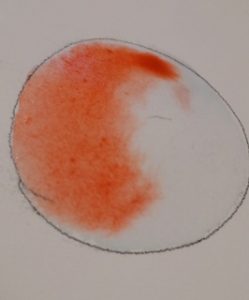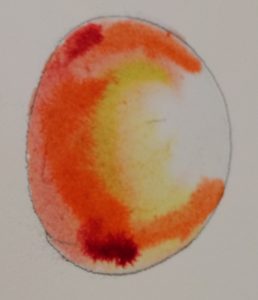 Although I have spent a lot of time in these posts talking about wet-on-wet and glazing, even negative painting, I have never taken you through the technique of Wet Blending. Let’s get caught up.
Although I have spent a lot of time in these posts talking about wet-on-wet and glazing, even negative painting, I have never taken you through the technique of Wet Blending. Let’s get caught up.
What IS wet blending?
It is any time you wet a small area and then paint into it.
If we go back to the rule that you are alway ALWAYS watching the ratio of how much water on my paper to how much water on my brush to how much pigment on my brush, remember that in wet blending we start with dry paper. You will want more water on your brush than when you work into wet-on-wet. And less pigment.

the shape is wet and I have drawn my brush in a c-shape around the outer edge, then overlapped that with a second stroke
You first wet the area you want to paint (usually confined by a shape you have drawn).
How wet? It should be shiny but there should be no standing puddles of water.
Let’s try a simple circle and turn it into an orange. Wet it. Now wet your brush (a # 10 or #12 round or a 1″ flat), blot it gently and pick up some orange paint. Mix yellow and red if you don’t have orange. I am using Daniel Smith Perinone Orange.
- If it is too much water you can pick up the excess with your brush

- If it is too little, it won’t be shining. Wet it so it glistens but no puddles.
- Do one c-shaped stroke along the edge.
- Do a second or third c-shape stroke, overlapping the pevious one
- If your brush was too wet and you brought in the paint you now will have stranding puddles that will become backruns if you don’t pick the excess up.
- If the paper is too dry your strokes won’t blend
Now try to change the color. Add a c-shape of yellow to the inner  curve and fuse it to the orange by overlapping the edge (photo at left).
curve and fuse it to the orange by overlapping the edge (photo at left).
I then added a second curve of orange at the mid- line and without working it too much added red to the  outer part of the c-shape (photo below).
outer part of the c-shape (photo below).
In each case, my brush wasn’t “too” wet and I watched to see that the shape still had its shine.
If you meet both of those criteria, it is easy to blend the colors together.
Now bring the colors on around. Keep the yellow a soft edge moving toward the highlight. Mine was still shiny and I decided I need more orange and more yellow so added them.
 You can see in the left side of the photo the shine.
You can see in the left side of the photo the shine.
When the shine goes off you need to stop working — unless, your brush is quite dry, but be careful! It is better to stop and finish later by rewetting the shape and adding another layer (glaze) to finish.
 I made it — here is the finished orange.
I made it — here is the finished orange.
Try this again and again and again until you master the control of wet blending.
How much water is the RIGHT amount of water? You only learn by doing it over and over so you can “sense” it. And how much pigment is the right amount?
How do you know? Practice something this simple often enough and you will come close to knowing…. and be able to adjust more quickly when it is too much or two little.
 If you get tired of doing a round shape, try something else. The fish, above, are an example of having fun with the wetting-the-shape-and-adding-color process.
If you get tired of doing a round shape, try something else. The fish, above, are an example of having fun with the wetting-the-shape-and-adding-color process.
I am stopping now so you can practice this.
We will take it further next time.
Happy painting,
Caroline
©2018, Caroline Buchanan
